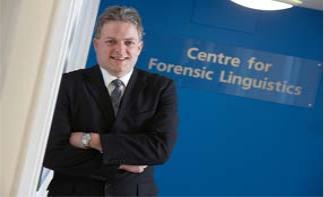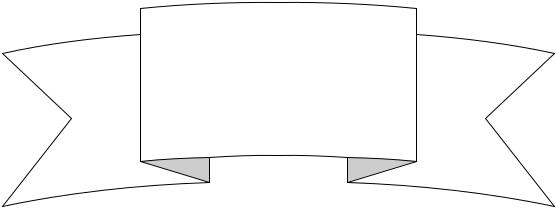
Английскй учебник
.pdf

11.. .
1.What is forensic stylistics?
2.What are the main types of questioned authorship problems?
3.What is the difference between qualitative and quantitative approaches?
4.What is stylometry?
5.How is question writing analysis accomplished?
6.What does this analysis result in?
7.What is author identification based on?
TEXT
STYLISTICS AND QUESTIONED AUTHORSHIP
Forensic stylistics is the application of the science of linguistic stylistics to forensic contexts. The focus of forensic stylistics is author identification of questioned writings.
There are at least three types of questioned authorship problems. First, one may want to determine if one author wrote all the writings in a questioned set, i.e., if a particular writing, which may or may not be already accepted as part of a body (canon) of known writings, is consistent with the rest of the known writings. Second, one may be asked to compare a questioned writing with the writings of a large number of possible authors, if there are no obvious suspect authors. Third, the most common type of forensic problem is to assess the resemblance of a questioned writing to that of one author or a small number of candidate authors, if in fact possible suspect authors can be identified by external (nonlinguistic) means.
Linguistic stylistics uses two approaches to authorship identification: qualitative and quantitative. The work is qualitative when features of writing are identified and then described as being characteristic of an author. The work is quantitative when certain indicators are identified and then measured in some way, e.g., their relative frequency of occurrence in a given set of writings. Certain quantitative methods are referred to as stylometry. Qualitative and quantitative methods complement one another and are often used together to identify, describe, and measure the presence or absence of style-markers in questioned and known writings.
Typical cases of questioned authorship present a questioned writing to be compared or contrasted to the known reference writings of questioned writing one or more candidate authors. Such an analysis is accomplished by examining the writing style of all available questioned and known writings. The writing style is exhibited in underlying linguistic patterns internal to the habitual language used by the author. Results of this analysis may be 1) determination of resemblance of questioned writings to a common canon of known writings, 2) elimination or identification of one or more suspect authors, or 3) inconclusive with respect to data that support neither elimination nor identification.
Author identification is based on two well-documented facts: author-specific linguistic patterns are present in unique combination in the style of every writer, and these underlying patterns are usually established enough to be empirically described and measured by careful linguistic observation and analysis, making author identification possible.
344


FORENSIC |
|
QUESTIONED |
STYLISTICS |
? |
AUTHORSHIP |
|
|
|
APPROACHES |
PROBLEMS |
TYPICAL CASES |
ANALYSIS RESULTS
? |
|
? |
|
? |
|
? |
|
? |
|
|
|
|
|
|
|
|
|
|
|
? |
|
? |
|
? |
|||||
|
|
|
|
|
|
|
|
|
|
|
|
|||
|
|
|
|
|
|
|
|
|
|
|
|
|
|
|
|
|
|
|
|
|
|
|
|
|
|
|
|
|
|
|
|
|
|
|
|
|
|
|
|
|
|
|
|
|
|
|
|
|
|
|
|
|
|
|
|
|
|
|
|
16., & $# .
17.( .
Q: * $ ! - ?
A: Intuition is the analyst's use of his or her own judgment to discover linguistic variation and suggest initial hypotheses to investigate. As a speaker or writer of the language and as a linguist, the analyst uses introspection to start the process of analysis.
Q: * ! !" - -
?
A: Stylistic analyses are both qualitative and quantitative, but the description of written language is the first and most important means for discovering style variation and identifying the writer of a document. The focus of a qualitative study of writing is a systematic linguistic description of what forms are used by a writer and how and why they may be used.
Q: * ! $ !- -?
A: The scientific basis of the argument is that of any empirical study: observation, description, measurement, and conclusion. In the specific case of authorship studies, the argument is as follows:
•Notice these style-markers in the corpus of writing.
•Each of these markers has x probability of occurring in the writing of the speech community.
•Taken as an aggregate set, they have y probability of occurring together in one writer.
•The author-specific markers and their joint probability of occurrence are either the same as or the same as or different from those of comparison corpus of writing.
346
UNIT 3. PLAGIARISM
1. .
1.Do you know what plagiarism is?
2.How can you define plagiarism?
3.Do you know the types of plagiarism?
4.Is it easy or difficult in your opinion to detect the cases of plagiarism?
5.Have you ever plagiarized?
6.In what professional spheres do people often face the cases of plagiarism?
7.Do students often plagiarize writing their term-papers?
8.Is plagiarism a crime?
9.Should people be punished for plagiarism?
10.What punishment would you establish for plagiarism if you were a legislator?
2. .
TEXT
PLAGIARISM
Plagiarism, as defined in the 1995 Random House Compact Unabridged Dictionary, is the "use or close imitation of the language and thoughts of another author and the representation of them as one's own original work." Within academia, plagiarism by students, professors, or researchers is considered as academic dishonesty or academic fraud and offenders are subject to academic censure, up to and including expulsion. In journalism, plagiarism is considered as a breach of journalistic ethics, and reporters caught plagiarizing typically face disciplinary measures ranging from suspension to termination.
While plagiarism in scholarship and journalism has a centuries-old history, the development of the Internet, where articles appear as electronic text, has made the physical act of copying the work of others much easier, simply by copying and pasting text from one web page to another.
There are several different kinds of plagiarism:
Type I: |
Copy & Paste |
Type II: |
Word Switch |
Type III: |
Style |
Type IV: |
Metaphor |
Type V |
Idea |
Plagiarism detection is the process of locating instances of plagiarism within a work or document. The widespread use of computers and the advent of the Internet have made it easier to plagiarize the work of others.
Detection can be either manual or computer-assisted. Manual detection requires substantial effort and excellent memory, and is impractical in cases where too many documents must be compared, or original documents are not available for comparison. Computer-assisted detection allows vast collections of documents to be compared to each other, making successful detection much more likely.
347

The examples below were originally written by the writing center staff at an esteemed college. The original text from Elaine Tyler May's "Myths and Realities of the American Family" reads as follows:
Because women's wages often continue to reflect the fiction that men earn the family wage, single mothers rarely earn enough to support themselves and their children adequately. And because work is still organized around the assumption that mothers stay home with children, even though few mothers can afford to do so, child-care facilities in the United States remain woefully inadequate.
Here are some possible uses of this text. As you read through each version, try to decide if it is a legitimate use of May's text or a plagiarism.
Version A:
Since women's wages often continue to reflect the mistaken notion that men are the main wage earners in the family, single mothers rarely make enough to support themselves and their children very well. Also, because work is still based on the assumption that mothers stay home with children, facilities for child care remain woefully inadequate in the United States.
Plagiarism: In Version A there is too much direct borrowing of sentence structure and wording. The writer changes some words, drops one phrase, and adds some new language, but the overall text closely resembles May's. Even with a citation, the writer is still plagiarizing because the lack of quotation marks indicates that Version A is a paraphrase, and should thus be in the writer's own language.
Version B:
As Elaine Tyler May points out, "women's wages often continue to reflect the fiction that men earn the family wage" (588). Thus many single mothers cannot support themselves and their children adequately. Furthermore, since work is based on the assumption that mothers stay home with children, facilities for day care in this country are still "woefully inadequate." (589).
Plagiarism: The writer now cites May, so we're closer to telling the truth about the relationship of our text to the source, but this text continues to borrow too much language.
Version C:
By and large, our economy still operates on the mistaken notion that men are the main breadwinners in the family. Thus, women continue to earn lower wages than men. This means, in effect, that many single mothers cannot earn a decent living. Furthermore, adequate day care is not available in the United States because of the mistaken assumption that mothers remain at home with their children.
Plagiarism: Version C shows good paraphrasing of wording and sentence structure, but May's original ideas are not acknowledged. Some of May's points are common knowledge (women earn less than men, many single mothers live in poverty), but May uses this common knowledge to make a specific and original point and her original conception of this idea is not acknowledged.
Version D:
Women today still earn less than men — so much less that many single mothers and their children live near or below the poverty line. Elaine Tyler May argues that this situation stems in part from "the fiction that men earn the family wage" (588). May further suggests that the American workplace still operates on the assumption that mothers with children stay home to care for them (589).
This assumption, in my opinion, does not have the force it once did. More and more businesses offer in-house day-care facilities. . . .
No Plagiarism: The writer makes use of the common knowledge in May's work, but acknowledges May's original conclusion and does not try to pass it off as his or her own. The quotation is properly cited, as is a later paraphrase of another of May's ideas.
348


